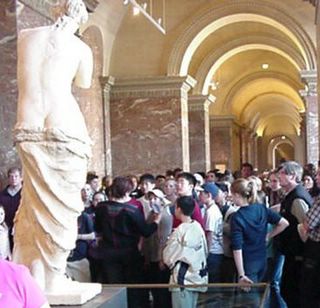As the guest of a friend I made a trip to San Antonio today to tour the new Mormon temple. The setting is beautiful, as is the building. The structure sits on a high point north of the city. With powerful lighting it will indeed be a lovely nighttime sight. The view from the hilltop is lovely.
I enjoyed trying to guess which visitors were Mormon. I’m pretty sure that the folks in front of me weren’t. They discussed the cost of the structure and the number of poor folks who could have been helped with that money. My host acknowledged that the structure probably cost about $3 or 4 million. I wouldn’t be surprised if it cost more than that. Apparently the LDS (Latter Day Saints Organization) is building about 3 such temples per year. Add to that the 400 or so new local meetinghouses and you’d arrive at a huge annual investment in property.
But their costs for personnel are almost nonexistent. Almost all of their ministry is done by members. And there were members in abundance at the temple today. As we walked to the entrance there was a "brother" or "sister" posted every three feet or so. At the entrance there were groups of younger kids who placed surgical booties over our shoes to protect the carpet inside. Since at least one of the carpets was creamy white, the booties were a great idea. The same kiddoes were there to accept the booties back at the conclusion of our tour.
The building itself is a collection of rooms. In the entryway a desk guards the passages that lead into the holier places beyond. Once the building is sanctified, only "worthy" members will be allowed to enter the structure. To be "worthy" one must be practicing the more strenuous points of doctrine (mostly diet and lifestyle issues), tithing, attending and serving regularly. There are special rooms for folks to dry off and dress after baptisms. Church members wear white whenever they enter the temple.
Baptisms for dead ancestors take place in a beautiful and roomy area. The baptistry brings to mind the laver outside the Jewish tabernacle and temple. The pool itself sits on the backs of twelve statues of bulls. I was surprised to learn that this pool is only for "vicarious" baptism, otherwise known as "baptism by proxy." This is a main reason for the Mormon interest in genealogy. Family is central to Mormon teaching, but the genealogical search allows members to do for ancestors what those people didn’t do for themselves. At judgment the recipient of baptism by proxy will be able to accept or reject it. A member’s own baptism takes place back in their normal meetinghouse.
There were also three rooms to symbolize the progression in knowledge leading to the celestial presence of our Heavenly Father. The first room for instruction was smaller and furnished with a screen for audiovisual materials. The second room was larger with wider seats and an "airier" feel. The third room was the celestial room where everyone was silent to allow the peace of the place to enfold us. The celestial room signifies the presence of the Father to which all believers aspire.
The other significant room was the "sealing" room. It is here that Mormon couples will be joined for this life AND eternity. The sealing also allows families to be joined for eternity based on Christ’s promise to Peter that whatever he bound on earth would also be bound in heaven. There was space for several other rooms but our tour was limited to the ones mentioned.
I had heard that Mormons believe that before being born souls meet with the Heavenly Father to hear about their specific future. Each spirit being is then allowed to choose or reject human existence. Apparently that isn’t quite right. The more orthodox belief says that "premortal" spirits are warned that human life has various perils (not the specific ones they will encounter) and then given the opportunity to take on an earthly body without knowing which body it will be.
The literature provided at the conclusion of the tour says: "Church membership in Texas since 1977 has soared from 50,000 to more than 245,000.
Stationed along the roads to offsite parking were several individuals offering literature to counter the temple experience. Several groups are listed as contributing to these newspapers: Calvary of South Austin, Mormonism Research Ministry and the Watchman Fellowship. It is curious to compare the soft sell materials presented in the temple experience to the more "in your face" approach of the opposition’s literature.
Hmm. This is intended to be a travelogue rather than an endorsement of Mormon doctrine. But I am impressed with the moral rectitude of most of those folks. I would remind the reader that Mormons use familiar Christian terms with meanings very different from traditional usage. "Heavenly Father" for instance may not mean the same thing to a Mormon than it does to others. Probably the most important difference will be in the understanding of Jesus, the Christ. The Christ of the Mormon is NOT the Christ of Scripture. Whenever common words are used in uncommon ways confusion is bound to occur. One has to wonder about the motive for such confusion.
Allow me to close this entry with a plug for a book about a Mormon figure who’s been mostly expunged from their literature. The book comes from an LDS author. It contains too many footnotes but the story itself is amazing. Consider it:
Sidney Rigdon: A Portrait of Religious Excess by Richard S. Van Wagoner.



